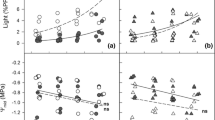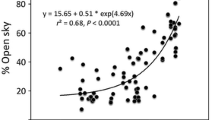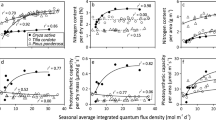Abstract
The influence of leaf orientation and position within shoots on individual leaf light environments, carbon gain, and susceptibility to photoinhibition was studied in the California chaparral shrub Heteromeles arbutifolia with measurements of gas exchange and chlorophyll fluorescence, and by application of a three-dimensional canopy architecture model. Simulations of light absorption and photosynthesis revealed a complex pattern of leaf light environments and resulting leaf carbon gain within the shoots. Upper, south-facing leaves were potentially the most productive because they intercepted greater daily photon flux density (PFD) than leaves of any other orientation. North-facing leaves intercepted less PFD but of this, more was received on the abaxial surface because of the steep leaf angles. Leaves differed in their response to abaxial versus adaxial illumination depending on their orientation. While most had lower photosynthetic rates when illuminated on their abaxial as compared to adaxial surface, the photosynthetic rates of north-facing leaves were independent of the surface of illumination. Because of the increasing self-shading, there were strong decreases in absorbed PFD and daily carbon gain in the basipetal direction. Leaf nitrogen per unit mass also decreased in the basipetal direction but on a per unit area basis was nearly constant along the shoot. The decrease in leaf N per unit mass was accounted for by an increase in leaf mass per unit area (LMA) rather than by movement of N from older to younger leaves during shoot growth. The increased LMA of older lower leaves may have contributed directly to their lower photosynthetic capacities by increasing the limitations to diffusion of CO2 within the leaf to the sites of carboxylation. There was no evidence for sun/shade acclimation along the shoot. Upper leaves and especially south-facing upper leaves had a potential risk for photoinhibition as demonstrated by the high PFDs received and the diurnal decreases in the fluorescence ratio F v/F m. Predawn F v/F m ratios remained high (>0.8) indicating that when in their normal orientations leaves sustained no photoinhibition. Reorientation of the leaves to horizontal induced a strong sustained decrease in F v/F m and CO2 exchange that slowly recovered over the next 10–15 days. If leaves were also inverted so that the abaxial surface received the increased PFDs, then the reduction in F v/F m and CO2 assimilation was much greater with no evidence for recovery. The heterogeneity of responses was due to a combination of differences between leaves of different orientation, differences between responses on their abaxial versus adaxial surfaces, and differences along the shoot due to leaf age and self-shading effects.
Similar content being viewed by others
Author information
Authors and Affiliations
Additional information
Received: 2 February 1999 / Accepted: 30 June 1999
Rights and permissions
About this article
Cite this article
Valladares, F., Pearcy, R. The geometry of light interception by shoots of Heteromeles arbutifolia: morphological and physiological consequences for individual leaves. Oecologia 121, 171–182 (1999). https://doi.org/10.1007/s004420050919
Issue Date:
DOI: https://doi.org/10.1007/s004420050919




